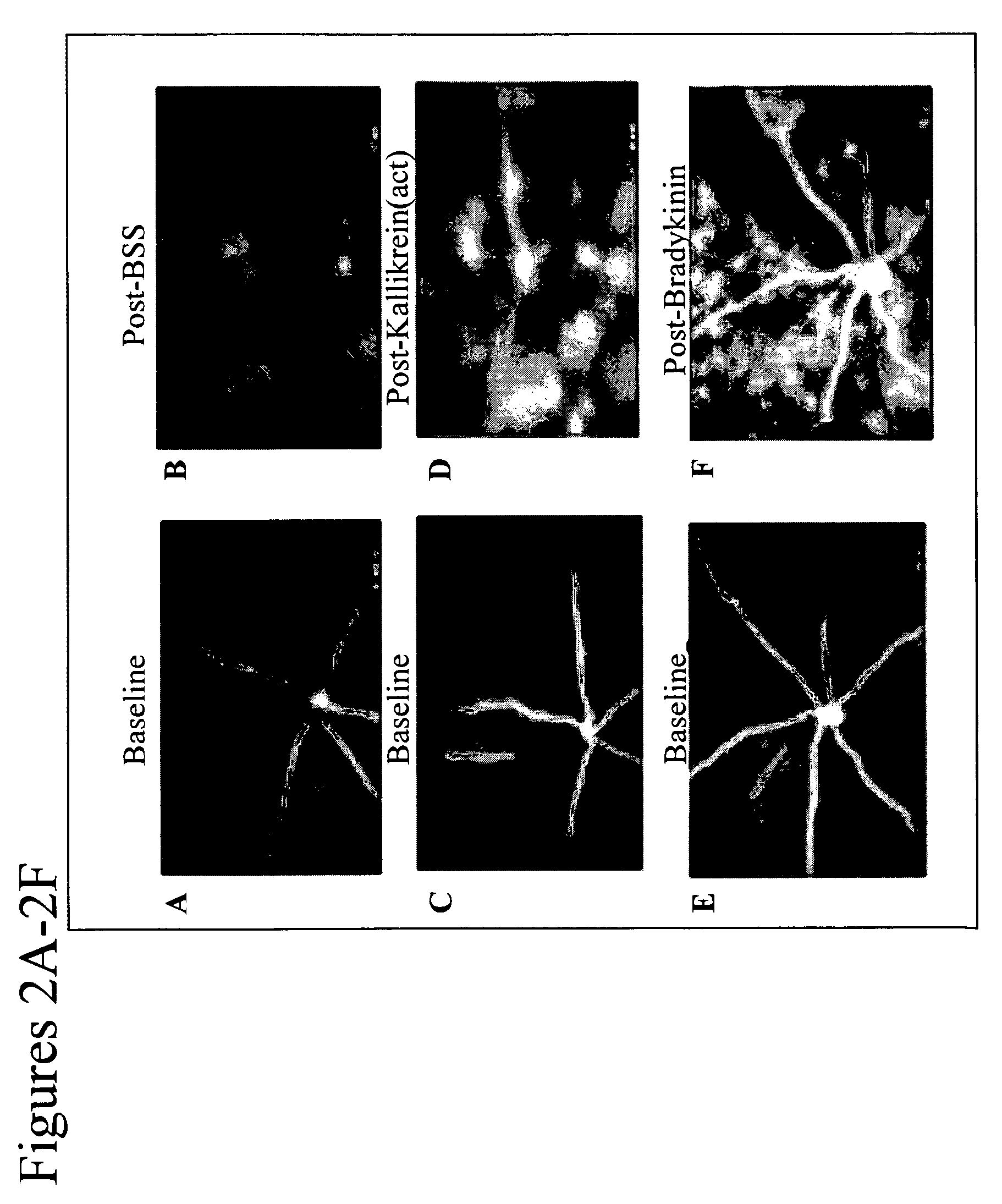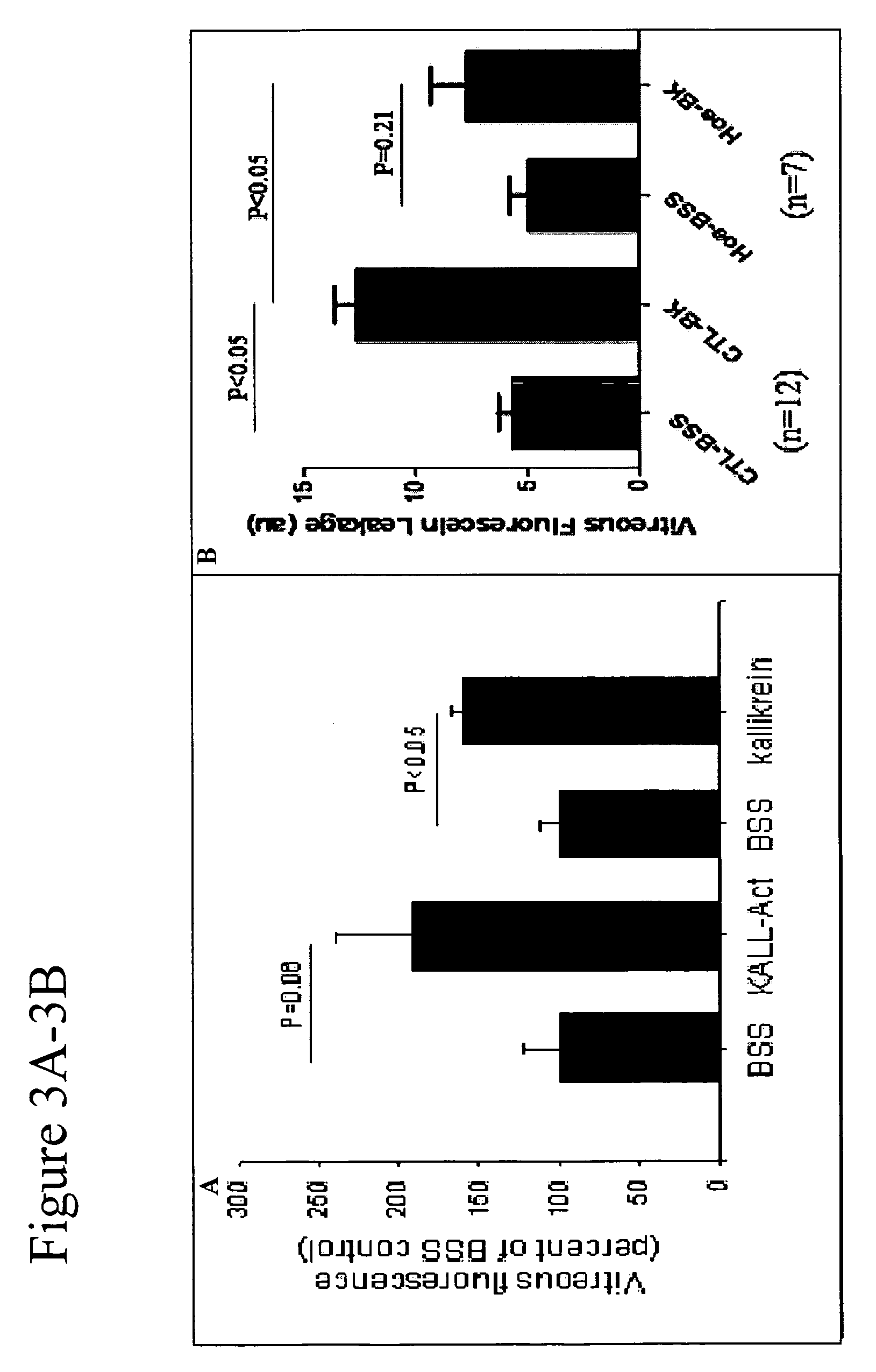Methods for treatment of kallikrein-related disorders
a kallikrein and plasma technology, applied in the field of plasma kallikrein related disorders, can solve the problems of legal blindness, delay in onset, slowing of the progression of diabetic retinopathy, etc., and achieve the effect of reducing the likelihood of occurrence or severity of a disease, and increasing the risk of developing
- Summary
- Abstract
- Description
- Claims
- Application Information
AI Technical Summary
Benefits of technology
Problems solved by technology
Method used
Image
Examples
example 1
Activation of the Kallikrein Pathway Increases Retinal Vascular Permeability
[0132]Activators of the kallikrein pathway, including purified activated plasma kallikrein, factor XII (FXII), high molecular weight kininogen (HK), and bradykinin, increase retinal vascular permeability (RVP) to fluorescein. In addition, inhibitors of the kallikrein pathway, such as complement I inhibitors and α2-macroglobulin reduced RVP. Direct injection of these kallikrein pathway activators into the vitreous was observed by SLO fundus imaging of the leakage from first phase fluorescein following bolus intravenous injection (FIG. 2) and by vitreous fluorophotometry, which measure the levels of fluorescein in the vitreous 30 min after intravenous injection (FIG. 5A). RVP is acutely increased by both intravitreal injection of the mixture plasma kallikrein, FXII, and HK (KALL-Act) (FIG. 3A). In addition, intravitreal injection of bradykinin can acutely increase RVP (FIGS. 2A and 2B). Moreover, pretreatment ...
example 2
The Kallikrein Inhibitor ASP-465 and ASP-440 Reduces RVP
[0134]We examined the effect of the kallikrein inhibitor ASP-465 on RVP induced by angiotensin II (AngII). Systemic delivery of AngII for 3 days via an Alzet subcutaneous osmotic pump increased systemic blood pressure (data not shown) and increased RVP (FIG. 6). Treatment of rats with both AngII and ASP-465 simultaneously via 2 Alzet pumps for 3 days displayed normal levels of RVP (FIG. 6). Systemic delivery of AngII for 7 days via an Alzet subcutaneous osmotic pump increased systemic blood pressure (data not shown) and increased RVP (FIG. 7). Treatment of rats with both AngII and ASP-440 simultaneously via 2 Alzet pumps for 7 days displayed normal levels of RVP (FIG. 7). Diabetes for 28 days increased RVP, as measured using the Evan's blue dye method (FIG. 8). Treatment of rats with ASP-440 upon confirmation of STZ-induced diabetes displayed normal levels of RVP (FIG. 8). These results suggest that inhibition of plasma kallikr...
example 3
Effects on Plasma Kallikrein on Intracellular Signaling in Astrocytes
[0135]We have also studied the effects of plasma kallikrein pathway activation on astrocytes. Bradykinin induces ERK phosphorylation in brain astrocytes and this effect on astrocytes is blocked by Hoe140, indicating that the response is mediated via the bradykinin type 2 receptor (B2-R; data not shown). Exposure of astrocytes to plasma kallikrein potently stimulated ERK phosphorylation, and this action of kallikrein on astrocytes is not affected by B2-R antagonism (Hoe140). The effect of kallikrein on astrocytes was blocked by leupeptin, a protease inhibitor and C1-INH (data not shown). Time course studies demonstrated that plasma kallikrein induced a prolonged activation of ERK, which was sustained for 2 hours (FIG. 9A). This is in contrast to the bradykinin effect, which is rapid and transient (data not shown). Plasma kallikrein's effect on ERK phosphorylation in astrocytes is dose dependent, reaching a maximal e...
PUM
| Property | Measurement | Unit |
|---|---|---|
| altitude | aaaaa | aaaaa |
| depth | aaaaa | aaaaa |
| depth | aaaaa | aaaaa |
Abstract
Description
Claims
Application Information
 Login to View More
Login to View More - R&D
- Intellectual Property
- Life Sciences
- Materials
- Tech Scout
- Unparalleled Data Quality
- Higher Quality Content
- 60% Fewer Hallucinations
Browse by: Latest US Patents, China's latest patents, Technical Efficacy Thesaurus, Application Domain, Technology Topic, Popular Technical Reports.
© 2025 PatSnap. All rights reserved.Legal|Privacy policy|Modern Slavery Act Transparency Statement|Sitemap|About US| Contact US: help@patsnap.com



